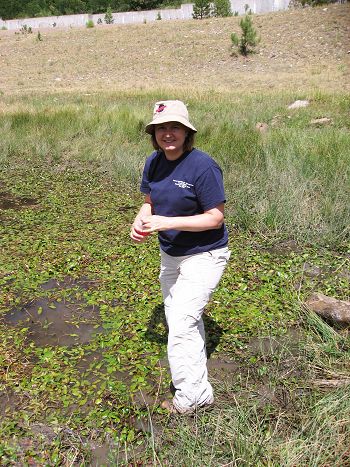Critical Zone Profile - JENNIFER MCINTOSH (hydrobiogeochemist, associate professor)
Water supplies for cities in the western U.S. originate primarily from winter precipitation in the high mountains – which means that the amount and timing of snowmelt are critical determinants of available water resources in this region. Climate change is reducing the amount of precipitation falling as snow, while fires, drought, and insect infestation are causing widespread mortality of forests from Mexico to Canada. My work is aimed at understanding how climate change and forest fires will affect water availability and quality for future generations.
“By studying how disturbances such as climate change and forest fires alter water storage, soil formation and nutrient cycling, and water quality, our Critical Zone Observatories can help us better manage natural resources.” – Jennifer McIntosh
The critical zone (CZ) is where drinking water supplies are stored in the subsurface. The processes that occur in this zone influence water storage and quality and provide important nutrients for ecosystems. By bringing together scientists from different backgrounds to work in one place – at the Critical Zone Observatories (CZOs) – we gain a deeper and broader understanding of fundamental CZ processes.
My work aims to understand how climate change, forest fires, and landscape characteristics alter the quantity and quality of water in high-elevation mountain catchments, which provide important water resources for cities like Tucson and Albuquerque. By studying how long it takes for snowmelt and rainwater to percolate through mountain catchments and discharge into streams, we gain new knowledge about subsurface structure and groundwater storage that can indicate how vulnerable these mountain catchments may be to climate change.
Through our studies, we have discovered that north-facing watersheds maybe more resilient to climate change – as thicker soils from enhanced weathering provide more groundwater storage, which sustains stream flow during drier periods.
Forest fires are expected to increase in intensity and frequency in the western U.S. as a result of climate change – with unknown consequences for water quality. To address this issue, we are studying the effects of a recent forest fire in the Jemez Mountains of New Mexico on water chemistry. Specifically, we are looking at how precipitation chemistry changes through interaction of raindrops with burned versus unburned trees. By studying the chemistry of raindrops interacting with burned versus unburned trees, we can understand how forest fires change the chemistry of water that eventually recharges groundwater resources.
CRITICAL ZONE OBSERVATORIES (CZO)
The CZO network has provided me access to natural laboratories in different geologic and climate settings, each with high quality and diverse datasets, at which to study earth surface processes. The network has also helped me to recruit great students who are interested in and excited by interdisciplinary research. The CZO National Office is helping to make the program more impactful by translating our research activities and findings to the broader scientific community and to the public.
I think critical zone scientists should strive to do a better job of communicating why our research matters. To that end, our Santa Catalina Mountains and Jemez River Basin CZO team has been working closely with Education and Public Outreach coordinators at the University of Arizona, who are putting together exhibits about our work to be displayed at Flandrau Science Center and at Biosphere 2 (B2). B2 is a science research facility that is open to the public and hosts hundreds of thousands of visitors per year.
:: By Linda Copman, staff writer ::
Sampling stream water beneath the snowpack in the Jemez River Basin Critical Zone Observatory.
Sampling a spring in the Jemez River Basin Critical Zone Observatory.
Discipline Tags and CZOs
Hydrology
Water Chemistry
Biogeochemistry
Geochemistry / Mineralogy
National
Catalina-Jemez
Related News
Explore Further







